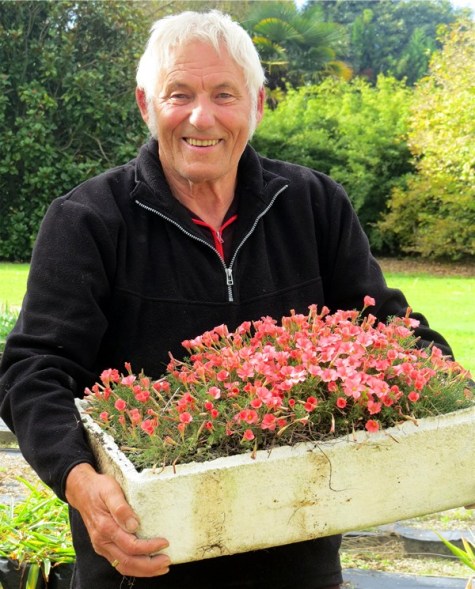From football-size to those as small as grains of sand, bulb enthusiast Bill Dijk loves them all.
“I call myself a bulbophile,” he laughs. “It’s an addiction and it started with a friend who gave me half-a-dozen daffodil bulbs on condition I entered the flowers in a show. I won a prize and was hooked – and the next year he gave me more.
“It developed to the point where I started to look for something else and got interested in bulbs from South Africa, partly because they suit my local climate.”

Bill Dijk with a tray of Oxalis massoniana, a bulb native to South Africa. Photo: Sandra Simpson
Bill and wife Willie, both Dutch by birth, moved to the outskirts of Tauranga from the South Island 44 years ago with a plan to start a kiwifruit orchard. Instead, and after working 5 years for someone else, Bill set up Daffodil Acres – about 4 acres growing some 300 to 400 daffodil varieties – that eventually morphed into a mail-order business for rare and unusual bulbs.
Now retired, Bill is enjoying growing simply for pleasure and is indulging his interest in breeding, particularly tall bearded iris and miniature daffodils.
“I started my love of bulbs with daffodils and when you start with daffodils you suffer from yellow fever for the rest of your life,” he says.

Grown by Bill Dijk, from left, ‘Tweeny’, Narcissus calcicola, ‘Lively Lady’, ‘Little Flik’ (from his own breeding porgramme) and ‘Segovia’. Photo: Bill Dijk
Among his breeding successes are Wilma (named for Willie), Little Emma and Little Becky (named for granddaughters), Daffy Duck and Dainty Monique.
“The idea is to breed something better than the parents – better form, better colour, a good cut flower,” Bill says. “It’s an exciting hobby because you’re hoping it will be something people will like.”
He’s spent 10 years on a scented, miniature green daffodil and reckons it might need only one more cross with Narcissus viridiflorus, a green species bulb, to have the flower he wants. He’s had a flowering with the scent and size he wants, but only touches of green and wants to make the green stronger.
Bill has noticed that miniature daffodils are especially popular with women, while men prefer big-flowered daffs. “Perhaps men think that because the miniatures are dainty they’re difficult to grow, but they can grow anywhere and are particularly suited to rock gardens and pot culture.”

Native to South Africa, Massonia pustulata is summer dormant. Photo: Bill Dijk
His extensive collection includes everything from the giant Brunsvigia josephinae (candelabra lily) to, well, several types of Oxalis.
“Collectors love Oxalis but no one else wants to hear about them,” says Bill, a member of the Pacific Bulb Society. “They flower prolifically for months on end, come in every colour, are easy to grow, and the majority aren’t rambling or weedy. I always advise people to put them in a pot and then you won’t lose track of them – and you’ll probably feel better about having them contained.
“Oxalis really would be one of my top recommendations when it comes to bulbs.”
Bill, who “dabbles” in clivia, has become keen on Lachenalias, especially those with interesting foliage – the raised spots of L. pustulata or the types with spotted leaves. He’s trying to add purple spotting to the leaves of L. viridiflora, which blooms with turquoise-coloured flowers in early winter.

Lachenalia viridiflora or the turquoise hyacinth. Photo: Sandra Simpson
“I’m getting too old to start things from seed – I’m 82 this year. I want to see things flower this year or next.
“But 3 years ago I imported a few seeds of the blue hippeastrum [Worsleya procera], I couldn’t resist. I may have to wait another 2 or 3 years for a flower so I hope to be around to see it.”
* * *
Bill’s Top Bulb Tips:
- Check how deep the bulbs should be planted – most common spring-flowering bulbs go in about 2.5 times their length, while many South Africa-origin bulbs like their shoulders above ground. However, Bill believes it’s not necessary to be 100% accurate as “nature will correct”.
- Choose a sunny, well-drained, open situation. If you’re likely to forget where the bulbs are, mark the site, draw a plan, or use bulb baskets.
- Before planting, dig the ground over and incorporate compost.
- Never cut off yellowing foliage – it’s feeding next year’s flower. Plant annuals or other, later-flowering bulbs to hide die back.
- Bulbs in pots are easier to keep track of and, once they’re finished flowering can be moved to hide dying foliage.
- To keep bulbs flowering well, divide the clump every 3 or 4 years, and keep the site weeded.
- If you can afford to, repot bulbs every year to keep up flower production. Ensure there is slow-release fertiliser in the new mix, which should be free draining.
- Bill makes his own planting mix with pumice, compost and sand as the three main ingredients, plus a slow-release fertiliser.
This article was first published in NZ Gardener and appears here with permission.

Pingback: Jean’s rare bulb in flower | Tauranga Orchid Society
Pingback: Heloniopsis orientalis | Sandra's Garden